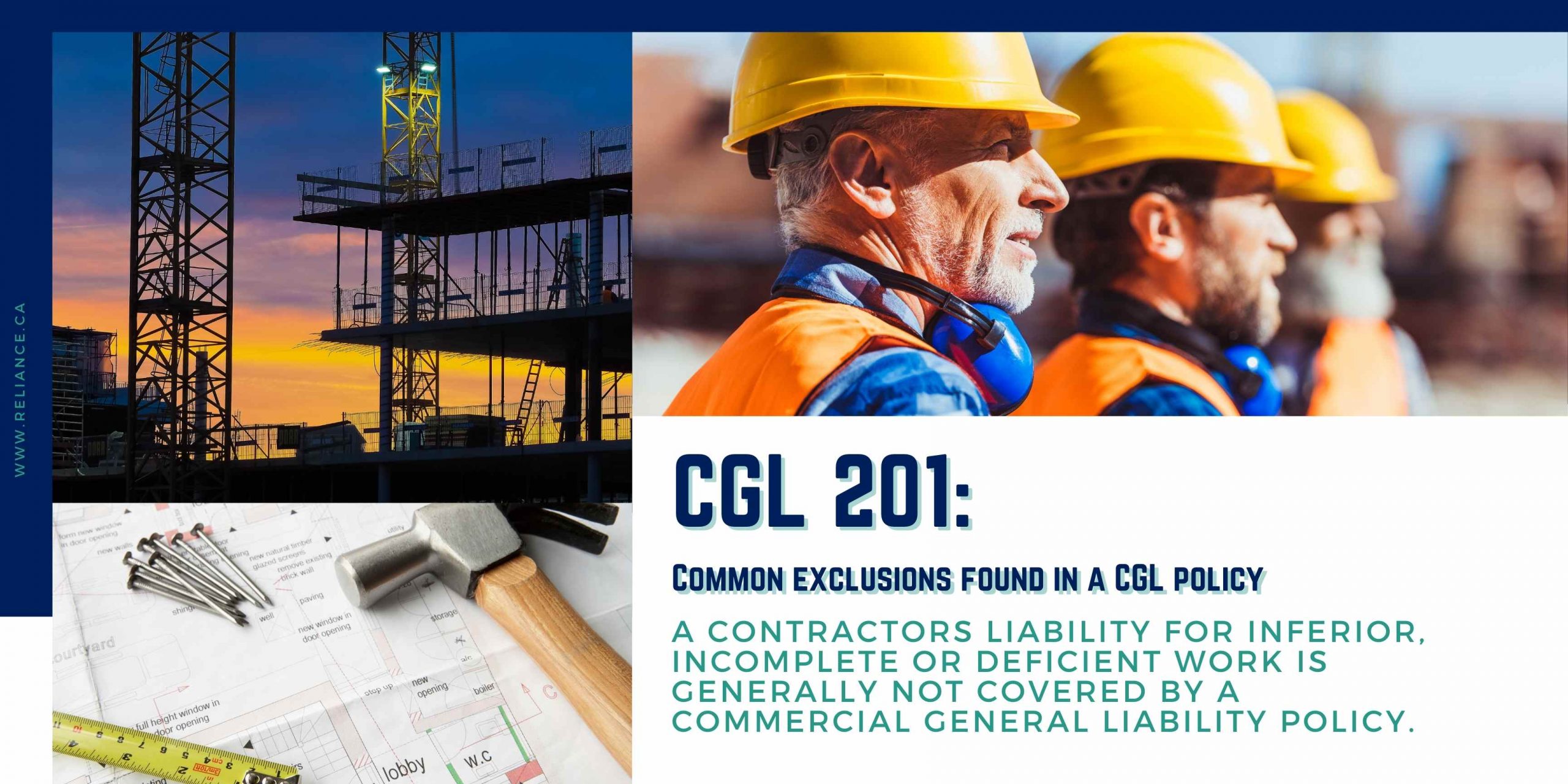CGL 201: Common exclusions found in a CGL policy
What is a CGL policy exclusion?
As we previously covered a CGL policy primary protects for bodily injury, property damages, advertising injury and personal injury to a third party. But with all insurance policies it is the “wordings” that outline the exact coverages. You can find a summary in your declaration pages which is essentially a summary of the contract between you and your insurance company. It outlines what each party is responsible for. The insured (you) are responsible for paying your insurance premium, and for providing your insurance company with correct information. Not only is it important to understand what is covered but also what are the policy exclusions.
A good insurance agent will ask you questions and lots of them about your business in order to find the best coverage for your type of industry, where your business is located and what your risk tolerance is. However, there are a number of exclusions that every business owner should be aware of so alternative coverage can be considered.
5 most common exclusions found in a CGL policy
- Work performed exclusion
- Co-employee bodily injury coverage
- Product Itself exclusion
- Contractual liability exclusion
- “Care, custody and control” exclusion
Exclusions
Workmanship – Work Performed
Many insurance policies have exclusions, for example a contractors liability for inferior, incomplete or deficient work is generally not covered by a Commercial General Liability policy. The risk and cost sharing between the insured (the company) and the insurer (underwriter) is the underlying principle of CGL. It is these principles that a court will use when they need to interpret the coverages in the case of a lawsuit. It is also important to note that the work performed exclusion does not apply if the damaged work or the work out of which the damage arises was performed on your behalf by a subcontractor.

Co-employee coverage
If that liability occurs because of negligence of an employee the business would expect that the policy would also protect any employee who may be named as a defendant in the resulting lawsuit. A CGL policy does generally provide coverage for employees who cause bodily injury or property damage to third parties “in the course and scope of their employment” with their employer. But where there is a gap in coverage is a CGL policy does not cover bodily injury to co-employees on the job. A lawsuit from 2001 led a precedent when an articling student, out with co-workers had a bad slip and fall. She sued her co-worker who had accidentally fallen upon her. She also sued the law firm and the employee. The incident and the lawsuit was reported to the law firm’s CGL insurer but the insurer would not defend the employee defendant invoking the standard exception in the “who is an insured”.
Product itself exclusion
The product itself exclusion is was designed to ensure the CGL policy was not used to cover the cost of repairing for replacing faulty or defective the insured own products. Most CGL policies will contain a product itself or your product exclusion clause. However, it does not exclude coverage for bodily injury or property damages that might be caused by the faulty product
Care, custody and control exclusion
The exclusion is typical of most CGL policies, and excluded coverage for property damage to personal property in the insured’s care, custody or control.
The exclusion applies only to personal property, not real property such as buildings or permanently attached fixtures. The exclusion applies if any of the three terms are true—not all need to be met.
- Care: temporarily having the responsibility of watching over property
- Custody: implies safekeeping of property
- Control: refers to having power over property
This exclusion removes compensation for the insured when the personal property or “chattel” is damaged while in the care of the insured. This applies to items such as rental equipment or goods that are being transported. In summary, goods not owned by the insured but in their care will not be covered.
Real business examples where care, custody, or control applies
Several common scenarios could trigger the care, custody, or control exclusion. For example:
- An office equipment repair technician damages leased business equipment, such as a photocopier.
- An auto body repair shop mechanic drops a heavy piece of equipment and damages a customer’s truck.
- A private club with a coat-check service loses a members leather coat.
- A computer repair shop technician drops a customer’s laptop onto the floor, rendering the computer unrepairable.
In the above cases, the people or companies with general liability insurance had someone else’s property in their temporary possession and then damaged it. Because of the care, custody, and control exclusion, their general liability insurance policy would not provide coverage.
Individuals and businesses are able to purchase a variety of different insurance policies – such as Umbrella or Cargo and stock throughput Insurance – that would cover any gaps from a care, custody, or control (CCC) exclusion.




© Copyright 2024 Reliance Insurance Agencies Ltd. All Rights Reserved.